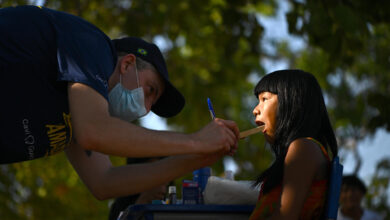The First 3 Latin American Women Doctors
Are you looking for a STEM reference? The Woman Post gives you 3 brilliant women graduates with honors in medicine and in the career they practice to get ahead in their personal lives.

The Woman Post | Abby Araujo
Listen to this article
Medicine, science, and technology are careers usually dominated by men, while in the areas of education and health women prevail. New data from the "Women for Oncology" group of the European Society of Medical Oncology (ESMO) indicates that there must be a gender balance in the oncology profession. The figures show only a 30% increase in female representation. The study's author, Anna Berghoff, believes that the number of women leading research, debates, and decision-making was stagnant and arguably even reduced.
In this sense, the situation is worrying because women of the next generations are required so that oncology can emerge positively, according to Nieves Sebastián published in the Gaceta Medica.
Ana Galvis Hotz, the First Female Doctor in Colombia
Historically, the need for trained midwives to help other women was reduced only to receiving the baby and cutting the umbilical cord. In this sense, no studies were required to practice it, such is the case of the renowned Juana Quevedo, who practiced the first operation would cease in Colombia, just because she is from a medical family. However, Ana Galvis Hotz was the first Colombian woman to graduate in medicine and the first woman specialist in gynecology. Very few women had a medical license to practice what they had learned, according to an article published in the Colombian Journal of Obstetrics and Gynecology by Fernando Sánchez.
Ana Galvis was the first woman physician to receive the degree of Doctor in 1877 and write a thesis about "Dissertation on the amniotic epithelium." There, she describes the cylindrical epithelium for the placental tissue layer. In addition, she used the microscope to accurately explain the functions of columns and intercellular channels.
The great woman had a double honor of specialization, which serves today as a STEM reference worthy of study and enhancement, not only as a woman but also as a professional and human.
Also read: CECILIA PORRAS TAKES COLOMBIAN ACADEMIC MISSION TO EXPO DUBAI 2020
Eloísa Díaz Insunza, First Woman Graduate in Medicine in Chile
Eloísa Díaz left an indelible mark on Chile, as she was the first Chilean woman to graduate as a doctor and was awarded several times. Her efforts in the thesis were based on “Puberty and the pathological predisposition of sex” which was published in 1886 in the Medical Journal of Chile and the University of Chile.
The leader promised significant reforms at the social level, including creating dental, medical services, kindergartens, polyclinics for vulnerable people, and school colonies at no cost. For some years, she dedicated herself to teaching and analyzing the health conditions of the country's schools. These actions led her to be an expert in the area.
She participated in several congresses and presented her ideas on school hygiene. In addition, she was a member of several institutions, such as the National League of Social Hygiene, the Scientific Society of Chile, the National Council of Women, the Medical Society, the Council of Primary Nutrition, and the Red Cross, according to the National Digital Library of Chile "Memoria Chilena."
The great woman fought against social damages and defended at all costs the health of the students. That is why she promoted mass vaccination to fight against rickets and tuberculosis.
Francisca Montaut De Osuna, the First Woman To Graduate in Medicine in Argentina
An article published in the Medical Journal of Rosario indicates how some women opted for other careers since the incorporation of women into the university was not easy in any country. In a photograph from 1923, in the first course of semeiology and propaedeutic clinic only 2 women Francisca Montaut and María Boljover are seen, a sample of the discrimination, exclusion, and social rejection of the right to an education that was a crucial part of those times.
Although in Latin America, the access of the female gender to higher education arose from the 1880s in the countries of Brazil, Mexico, Chile, Cuba, and Argentina, the equality of rights and their participation in independence was not immediate.
These three women are listed as the first professionals who activated gender participation in Latin America.




